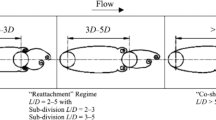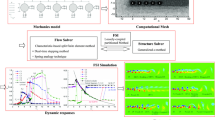Abstract
The vortex-induced vibration of two elastic cylinders in tandem has been numerically simulated based on the Galerkin finite element method and dynamic mesh technique. Influences of the reduced velocity to the amplitude of vibration displacement of the cylinders was investigated, with cylinder spacing of L/D = 5 and a Reynolds number of 1,000. In the simulation, several classic vortex-induced vibration modes have been obtained, such as beat vibration and resonance. It was found that vortices shed periodically from both the upstream and downstream cylinders. The downstream cylinder undergoes larger amplitude of oscillations in both transverse and streamwise directions than those of the upstream cylinder. Variations in the maximum amplitudes of the oscillation displacement were found to agree with the “three-branch” model.
Access provided by Autonomous University of Puebla. Download conference paper PDF
Similar content being viewed by others
Keywords
These keywords were added by machine and not by the authors. This process is experimental and the keywords may be updated as the learning algorithm improves.
1 Introduction
Flow-structure interaction in an arrangement of two cylinders in tandem is an important project for the research works of fluid mechanics, which has not been well understood. Previous works reveal some characteristics of this kind of flow phenomenon. Assi et al. (2006) experimentally investigated the oscillations of the downstream cylinder in a two-tandem circular cylinder arrangement. They observed that the oscillating amplitude of the cylinder increased with the reduced velocity. For the same reduced velocity, this amplitude is 50 % larger than that of a single cylinder. Price et al. (2007) experimentally investigated the vortex pattern and the vortex shedding frequency as the upstream cylinder vibrates in the transverse direction. Kim et al. (2009a, b) investigated experimentally flow-induced oscillations of two cylinders in tandem arrangement. Five wake vortex flow patterns have been observed in their experiments. Flow-induced oscillation of two cylinders in tandem has been investigated numerically by Prasanth and Mittal (2009) for a low Reynolds number of 100. In their work, mass ratio m* = 10, damping ratio ζ s = 0, cylinder spacing L/D = 5.5. They found that the variation in the amplitude of the transverse oscillation is in accordance with a three-branch model which is suitable for that of a single cylinder. Numerical studies have been conducted for one-degree-of-freedom and two-degree-of-freedom vortex-induced vibrations of the downstream elastic circular cylinder in tandem arrangement by Chen et al. (2004, 2005). Their results showed that the peak value of the displacement of the cylinder for two degree of freedom is larger than that for one degree of freedom, and the lift of the downstream cylinder is larger than the upstream cylinder, while it is contrary for the drag. Although many research works have been made on the flow-structure interactions, numerical studies on the flow-induced vibration of two cylinders in tandem for a higher Reynolds number are still lacking. In this work, flow-structure interactions of two cylinders in tandem were investigated numerically at a Reynolds number of 1,000.
2 Mathematic Model and Calculation Method
2.1 Governing Equation
For the unsteady incompressible flow of the fluid-induced vibration issue in this study, the continuity and momentum equations are:
The dimensionless parameters in the equations are \( X_{i} = x_{i} /D \), \( U_{i} = u_{i} /U \), \( P = (p - p_{0} )/\rho U^{2} \) and \( \tau = Ut/D \), where the characteristic length D is the diameter of the cylinder, U is the uniform flow velocity, p 0 is the inlet pressure, the Reynolds number \( Re = UD/\upsilon , \) and ν is the kinematic viscosity.
Introducing the spring damping vibration model, the vibration equation of the cylinder for two degree of freedom is:
In which, Y i is the displacement of the cylinder in x and y directions, ζ s is the dimensionless damping coefficient of the structure, \( F_{i} = (C_{D} ,\;C_{L} ) \) is the cylinder’s stress coefficient, mass ratio \( m^{*} = 4m/\rho \pi D^{2} \), m is the mass of unit length of the cylinder, ρ is the fluid density, the reduced velocity \( U_{r} = U/f_{n} D \), f n is the natural frequency of the cylinder.
2.2 Computation Model and Grid
The computations were carried out with Galerkin finite element method, at a Reynolds number 1,000, and spacing ratio L/D = 5. The two cylinders can vibrate with two degrees of freedom. The mass ratio is m* = 20.0, and the non-dimensional damping ratio is ζ s = 0.0. A dynamic grid technology was introduced to calculate the vibration of the two elastic cylinders. The k-ε model was chosen for the turbulence flow.
Two cylinders of equal diameter are placed in a 60 × 20 D rectangular domain, in which the length from the inlet to the upstream cylinder is 10 D. After defining u and v are the mean values of the streamwise and vertical velocity, the boundary conditions were set as: the inlet dimensionless u = 1 and v = 0, the outlet dimensionless pressure P = 0. The Neumann condition is employed in the inlet velocity, i.e., \( {{\partial u} \mathord{\left/ {\vphantom {{\partial u} {\partial x}}} \right. \kern-0pt} {\partial x}} = 0\;,{{\;\partial v} \mathord{\left/ {\vphantom {{\;\partial v} {\partial x}}} \right. \kern-0pt} {\partial x}} = 0 \). The non-slip boundary condition is employed in the upper and lower walls, u = 0, v = 0. The six-node triangle mesh was introduced in the computational domain and the mesh near the cylinder was refined. The number of grids is more than 60,000.
3 Results and Discussions
Figure 1 shows the time histories of the lateral displacement of the cylinder vibration. It is found that as the reduced velocity is increased, the vibration mode undergoes successively small vibration, beat, resonance, and small beat vibration. The upstream and downstream cylinders appear to be of similar varying rule in terms of the vibration mode, but the amplitude of the downstream cylinder is larger than that of the upstream. As the relative values of the natural frequency of the cylinder and the vortex shedding frequency varying, i.e., the value of U r was set at different values, the clap-frequency is varied consequentially. There are five and two beats at U r = 5 and U r = 5.5, as shown in Fig. 1b and c.
Figure 2 presents the variations of maximum oscillating displacement amplitudes of the cylinder as the reduced velocity is changed. When the natural frequency of the cylinder f n was set at 0.175 and U r = 5.75, the natural frequency is the same with vortex shedding frequency in magnitude, resonance phenomenon occurs both on the upstream and downstream cylinders, the displacement amplitudes reach maximum values. With the reduced velocity continuously increasing, the streamwise amplitudes of the upstream and downstream cylinders are both increasing, and the amplitude of the upstream cylinder is larger than that of the downstream cylinder (Fig. 2a). With regard to the maximum lateral displacement amplitude (Fig. 2b), the variation tendency of the upstream and downstream cylinders is the same. As being affected by the trailing vortex of the upstream, the amplitude of the downstream cylinder is larger than the upstream cylinder. The lateral variations of the two cylinders present a “three branch” mode. At the initial part, the amplitudes are very small. While for the middle part, the amplitudes reach maximum values, and those for the larger reduced velocity are smaller. These results are similar to the observations of Prasanth and Mittal’s (2009) and Khalak and Williamson (1999), in spite of some differences in data magnitude due to the difference in the Reynolds number, spacing ratio, and mass ratio.
4 Conclusions
A numerical simulation has been carried out on the vortex-inducted vibrations of cylinders in tandem at the spacing ratio of L/D = 5, with two degrees of freedom. The behaviors of flow-induced responses of the cylinders were examined as the reduced velocity is varied. The main conclusions are summarized as follows:
-
1.
The maximum lateral vibration amplitude of the downstream cylinder is larger than that of the upstream. The lateral vibration amplitude trend shows “three-branch” mode, which is similar to that of a single cylinder.
-
2.
With the reduced velocity varied, several vortex-induced vibration modes were captured, i.e., small amplitude vibration, beat, and resonance. When the resonance occurs, the vortex shedding frequency is increased.
References
Assi GRS, Meneghini JR, Aranha JAP, Bearman PW, Casaprima E (2006) Experimental investigation of flow-induced vibration interference between two circular cylinders. J Fluid Struct 22:819–927
Chen WQ, Ren AL, Li GW (2004) The numerical study of two-degree-of-freedom vortex-induced vibration of the downstream cylinder in tandem arrangement. Acta Mech Sinica 36(6):732–738 (in Chinese)
Chen WQ, Ren AL, Li GW (2005) Numerical simulation of flow-induced vibration on two circular cylinders in a cross-flow. Acta Aerodyn Sin 23(4):442–448 (in Chinese)
Khalak A, Williamson CHK (1999) Motion, forces and mode transitions in vortex-induced at low mass damping. J Fluid Struct 13:813–851
Kim S, Alam MM, Sakamoto H, Zhou Y (2009a) Flow-induced vibrations of two circular cylinders in tandem arrangement. Part 1: characteristics of vibration. J Wind Eng Ind Aerod 97:304–311
Kim S, Alam MM, Sakamoto H, Zhou Y (2009b) Flow-induced vibrations of two circular cylinders in tandem arrangement. Part 2: suppression of vibrations. J Wind Eng Ind Aerod 97:312–319
Prasanth TK, Mittal S (2009) Flow-induced oscillation of two circular cylinders in tandem arrangement at low Re. J Fluid Struct 25:1029–1048
Price SJ, Païdoussis MP, Krishnamoorthy S (2007) Cross-flow past a pair of nearly in-line cylinders with the upstream cylinder subjected to a transverse harmonic oscillation. J Fluid Struct 23:39–57
Acknowledgments
This work was financially supported by the National Natural Science Foundation of China (10972210) and Zhejiang Province Key Sci-tech Innovation Team Project (2009R50024).
Author information
Authors and Affiliations
Corresponding author
Editor information
Editors and Affiliations
Rights and permissions
Copyright information
© 2014 Springer-Verlag Berlin Heidelberg
About this paper
Cite this paper
Chen, H., Zhang, H.J., Zhang, C.J., Su, Z.D. (2014). Numerical Investigation on the Flow-Induced Oscillation of Two Elastic Circular Cylinders in Tandem. In: Zhou, Y., Liu, Y., Huang, L., Hodges, D. (eds) Fluid-Structure-Sound Interactions and Control. Lecture Notes in Mechanical Engineering. Springer, Berlin, Heidelberg. https://doi.org/10.1007/978-3-642-40371-2_54
Download citation
DOI: https://doi.org/10.1007/978-3-642-40371-2_54
Published:
Publisher Name: Springer, Berlin, Heidelberg
Print ISBN: 978-3-642-40370-5
Online ISBN: 978-3-642-40371-2
eBook Packages: EngineeringEngineering (R0)






